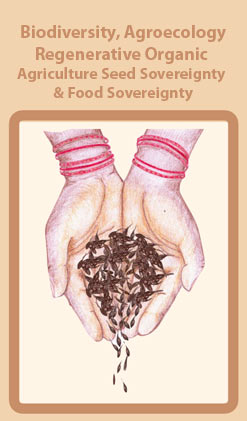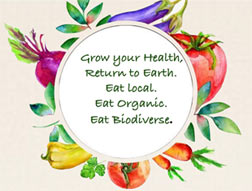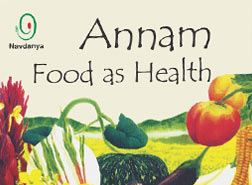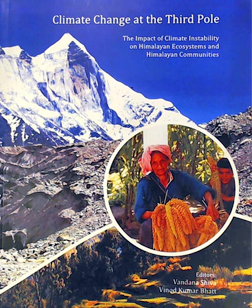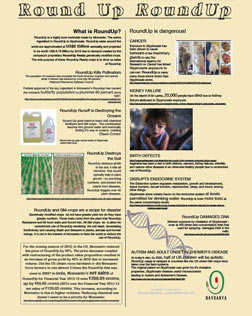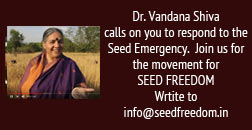Dr. Anna Powar
Why do we eat?Human body is the design of the evolution. Evolution or Nature makes the animals feel hungry to continue their species. The grass and plants don't eat. They manufacture food by synthesising five elements viz., carbon dioxide, oxygen, hydrogen and nitrogen. The same elements form the part of carbohydrates and fats in animals.
Throughout the world the people eat. It is a culture like an art, music, etc. The people have studied and have developed hundreds of recipes, which are culturally specific. The recipes supply carbohydrates, proteins and fats. These are like building blocks. The breaking down process of food by enzymes is called digestion. When protein breaks down it gives amino acids. We get fatty and sugars when fats and carbohydrates are digested.
Generally, the human body is compared to at machine or a car. In a machine the structure and car are separate components to run the machine. But in a human body the structure and functions are inseparable. The proteins, carbohydrates, and fats are the building blocks as well as responsible for functioning of the body.
Proteins: The proteins in the body are the working forces. The enzymes are proteins and hasten the processes. Calcium acts as a messenger and takes signals to different part of the body. The hormones spur activity present in pancreas and thyroid.
There are millions of proteins in our body. We have 20 building blocks of proteins, which take care of entire functioning of the human body. There are essential and non-essential amino acids. The functions of these amino acids are different. Both of them are vital for functioning of the body. There are 9 essential building blocks and 10 in children present.
The human beings across the world are biologically singular and culturally different. The needs and diet are varies from culture to culture viz., Indian, American, African, etc. The diet won't be same for the cultures. Food is the power means we have. The very smell of the food facilitates secretion of digestive juices.
Protein is very important because; protein is muscle, skin, etc. It is very essential that we should get the complete proteins from diets. Complete proteins refer to all the essential amino acids in sufficient amounts. In the vegetable kingdom, for example Indian diet, there is no such thing as complete protein. Indian recipes include cereals, legumes. Cereals include, rice, wheat, etc. The pulses are legumes. The combination of these provides the body the required complete amino acids. In case of soya bean it doesn't contain all the amino acids. Mediterranean region has complete protein diet includes cereals, legumes.
All over the world, the antibiotics are recommended in order to deal with viral diseases. The entire system is loaded with antibiotics. This is dangerous trend. If the higher strata of life are killed, who will build the lower ones. It is a food web. The virus population is increasing. The vaccines against virus don't work. By the time we realise the virus in our body, it would be at least 5 days. It is very essential to take a diet which has complete amino acids. Indian diet has cereals, legumes, and some animal products such as curd, ghee, etc. This combination is very good and supplies all the required amino acids.
We are turning our food into a commodity. The modern food habits are not following the cultural recipes for getting the supply of required proteins. They contain sugar which is not healthier – either beet or sugarcane. The man made sugar, such as saccharin has side effects cause insomnia, etc.
Proteins are necessary for transporting certain matters. For example, haemoglobin is protein, which transfers iron.
Carbohydrates: Carbohydrates are imperative for the body. At the same time both carbohydrates and protein are equally important even though both produce 4 calories each. The traditional foods have been developed over millennia and are time tested. The modern foods are not providing the required protection to the body. There will not be proper insulin function. The immune system is once again protein. Many anti bodies are protein. Carbohydrates can't substitute for proteins. The immune systems are made up of proteins. The haemoglobin has two chains. One of them is long and has 450 amino acids and the shorter one has 212 amino acids. All these amino acids are for one antibody. If the protein intake is not good, it affects the functioning of these systems.
Fats: One gram of carbohydrates is 4 calories. So also one gram of protein produces 4 calories, whereas one gram of fat is equivalent to 9 calories. The molecules of fats in the human body shares both structure and function in the same way as proteins and carbohydrates do.
In the human body energy is produced in and is known as the ATP. The body uses this energy in its functions such as breathing and performing other activities. The energy is stored in cell membranes of cell.
There are minerals and vitamins in our body, which are soluble in water and soluble in fats. Fat is stored in out layers of cell membranes. In order to perform certain functions, where energy requirement is more, large quantities of protein and carbohydrates are needed. Fat transports fat soluble vitamins at a faster pace.
The mammals provide milk to their off springs. Milk is water and protein. The evolution as said earlier is interested in species. In the case of human babies, mother milk is the most specific. Cow's milk is not suitable for human babies.
Sprouts contain more nutrients. Higher the amount of fibre content, lesser the absorption of nutrition. Cholesterol is the starting molecule for sex hormones.
Food has developed over thousands of years locally, geographically, depending on the choice and inclination of people, climatic conditions, and soil. Problems began when food is extrapolated from its environment and culture where it was started. In the modern living, food is taken like an aspirin for development or addressing particular problem in the body. It is totally a wrong way of taking foods.
It was emphasised again that evolution is interested in continuation of species. The eastern traditions viewed human as an integral part of the whole system. We extract oil from the plants. But actually, the plant makes oil for germination of its own seeds. The plant needs oil and fat for new life. It should be good oil. The fact consists of carbon links. Depending on the number of links it is called small, medium and long chain fatty acids. Fat contains 20 fatty acids. The new plant life requires good fatty acids. The factors such as cold and hot temperatures, climate affects the new life. In hot climate the plant needs unsaturated oils for new life. In temperate regions, the new plant requires saturated oils.
Fish has very long fatty acid chains. They have loose link i.e. they are highly unsaturated oils. It is because, the fish weeds and other plant materials in water. Consumption of oils which are native is healthier than oils which are produced by exotic plants. For example, sesame oil is good for people in north India and olive oils for Christians and Muslims in Middle East and Mediterranean regions. The commercialisation of good is tempering something which has evolved over millennia and the effects of which are felt in the generations to come. The present man thinks that he is at the top of the evolution pyramid. He has forgotten that he is part of the eco system.
Dr. Mira Shiva
Pesticides and FoodOils and Govt. Policies: The Govt. of India in 1990s’, imported genetically modified soya bean oil in the country from USA. The soybean oil was promoted as superior to locally produced oils from sesame, groundnut, coconut oils, etc. The native oils contain far more nutrients than soya bean. Europe didn’t want to import GMO soybean oil from US. The Indian thrust on the people of India. The govt started selling in packages. This deprived the poor people from by buying small quantities of oil for their daily needs. The extraction of oil soya bean requires chemicals and is energy intensive process. Whereas native oils don’t require chemicals. The ingestion of chemicals causes diseases in the body.
The hydrogenated oils used in the various foods. These are trans-fats. They are responsible for heartening the blood vessels, hypertension, and problems in joins. The govt. is taking making policy decision, which is not in the interest of the people’s health. The laborious process is extracting the rice brawn oil or sun flower oil involves chemicals. Large number of population in India doesn’t get sufficient cereals. The extraction of oil from rice renders lose of nutrients in rice.
The oil is very import for absorption of vitamins. It is made very expensive by the policies of the govt. making unaffordable for the people. The commercially processed refined oils are not healthy. The oils produced from crops native to India are good for health. The research done by the experts, sponsored by the big companies, is biased against the consumers. They promote products of these companies for profits.
Pluses: We are pulse eating country. We eat different diversity of pulses, viz., red gram, green gram, lentils, etc. which are nutritious and easily digestible. The germination and fermentation make food increases the nutrient values such as vitamin E,etc. The pulses are eaten with vegetables and greens. The ‘sathu’, is highly nutritious food. It is flour made up of roasting the sprouted chickpea. People, instead of making low cost nutritious themselves, buy companies promoted low value readymade food. The govt. imported ‘yellow pea dal’ from USA. It took longer time to cook than any Indian pulses. The pulses are being adulterated. As result of commercialisation, and devaluation of dals will lead to disappearance of pulses. Along with dals, the traditional recipes bound to vanish in the generations to come.
Spices :
Haldi (Turmeric): From generations people of India are using turmeric as a part of food. It has preventive health values and therapeutic properties. It is antiseptic and anti-cancer. It has anti- prostate cancer and anti inflammation properties. Using turmeric enhances the immunity. It is used in treating deep cut. There several invaluable properties contained in the turmeric. This knowledge has been developed by our ancestors over a period of time. The recent development is that turmeric contains anti Alzheimer properties. Unfortunately, the knowledge and wisdom of our ancestors are not taught in the formal medical education system.
The pharmaceutical companies are making sure that the traditional values and wisdom are devalued. The Indian spices used various recipes have more valuable than pharmaceutical products. The wisdom and knowledge in local traditions are not considered as science. The Indian research institute – Council for Scientific and Industrial Research fought against patenting of turmeric in USA.
The food production is linked to the whole issue of livelihood. In the west more food is wasted than eaten. As a result of adulteration of food at various levels and use of imported grains and oil seeds have increased the incidences of non-communicable diseases viz. Diabetes, hypertension, cancers, mental health, asthma, etc. Even communicable diseases, such as tuberculosis, waterborne diseases have also increased. The wide range of issues has become a threat to food sovereignty and nutrition security of the child. 46.6% of children under the age of 5 are malnourished. Pregnant women, women and elderly people are the most affected section of the society.
The commercial dairy products are loaded with hormones. Hydrogen peroxide is used to make synthetic milk. This area is of deep concern. The banned pesticides, for example, DDT, endosulfan, used on the field are entering the food chain. The gross grown are eaten by the farm animals. The milk, vegetables, food crops have been contaminated. The effect of pesticides in food is causing cancer, deformities in the new born babies. The mercury, which enters the pregnant women through food chain or mercury based medication, reaches the baby through placenta and umbilical cord. The toxicity of mercury grows and will have devastating effects on the child.
The traditional diets have checks and balances. Applying common sense is useful. Traditional food is tested for generations. Sharing traditional knowledge and unlearning modern food habits are of crucial importance. The present paradigm is an attack on family, faith and food.
Indigenous Knowledge v/s Nutrition
Dr. Anna Powar
Indigenous knowledge is defined as the collective knowledge of people, for the people over a period of time in a particular geographical area. Most of the academic institutions don’t recognize the indigenous knowledge. It is seen as against science. Science is a baby and knows numbers compared to the indigenous knowledge developed over generations. The indigenous knowledge operates latterly and has no hierarchy. The approach that the science adopts is top down. Science conducts experiments with certain principles in a given set of standards and is confined to a context. According to science it must be reproducible. But life is not reproducible. Life is not comparable. Science is not capable of understanding the dynamics of life. The indigenous knowledge guarantees life here and now for generations. The basic difference indigenous knowledge and science is that science operates in controlled conditions, where as life works in varieties of environment and adverse conditions. The life is subjected the conditions of body, brain and emotions, knowledge prevailed over generations in the local community. For example, the story of corn, this was brought to Italy. The corn belongs to big giant cereal family. It has amino acids. It is a staple of Mexico and other North American countries. In 1464, a diplomat from Italy visited Mexico and was amazed by the properties of corn. The Mexican people were strong and healthy. The diplomat brought the corn to cultivate in Italy. The farmers cultivated the corn and started eating. They farmers were affected by diseases after eating the cooked corn. The reason behind this was that the diplomat brought the corn without the indigenous knowledge to using it food. Italian farmers suffered from various diseases, diarrhoea, and dementia. They affected the skin and brain due to deficiency of vitamin B3. They didn’t know how get the vitamin B3 from the corn. To extract the vital vitamin B3 the Mexican used to grind the corn on a stone and by adding sweet lime to it. As a result of this process Mexican used to get vitamin B3, whereas the Italian didn’t have this precious knowledge to extract vitamin B3 due to lack of knowledge.
Now the World Bank has officially accepted the indigenous knowledge. Dr. Vandana Ji is now fighting against patent of turmeric. The traditional knowledge of India is five thousand years old. The turmeric has been used for ages. It doesn’t have the records like a science experiment. It is not done in a lab.
Most of the carbohydrates intake is from the consumption of wheat products. It is creating a problem due to presence of gluten. The people are suffering from colitis due to wheat eating. When the gut is inflamated, micronutrients will not pass through the gut. The indigenous people have studied agriculture, soils and plants. The farmers in semi-arid and arid regions have selected the crops which require little water to grow. The Indigenous knowledge is the harmonious way of meeting life. It has required knowledge to manage soil and water. The human being is integrated in the environment. It is a continuum. The farmers see every drop of water as a food. The soil is getting poorer due to depletion in the soil organic matter. The water holding capacity of soil is also getting reduced. The production system is going hey-wire. Everything is interconnected. The soil is the biggest dam on earth. If the capacity of soil to hold water is enhanced the dams may not be required for growing crops.
The modern view of life, is ‘either, or ’approach. It is either indigenous knowledge is or otherwise. The people have been influenced and are also getting influenced over a period of time. Indigenous knowledge has lot hopes. We can’t say it is wrong. The modern industry is trying to cash on the fears of people offering many food products. In the process of luring the consumers, they are cheating the people making false claims. The balanced diet advocated by the indigenous knowledge takes care of problem of the modern man. The modern view claims that cholesterol is bad for people. But high cholesterol is needed for the stressed people. One can’t form uniform rules for all. It all depends on the specific requirement of the individual person.
The food defines our identity – inner and outer ecosystems of human beings right from the birth of the child to become an adult. Earlier in semiarid regions of Asia and Africa, sorghum and corn used to be grown to source the carbohydrate requirement. Nowadays, people started growing wheat as well. The indigenous knowledge has developed recipes as per the availability of grains locally not based on the grain from far off place. Whatever the indigenous knowledge has in Africa has been wiped out by the corporations by giving formula for large scale industrial agriculture. It is a different in Africa. The baby food is being advocated to the children. The Africans are not cattle breeders and have no postures. Indigenous knowledge is not to be mixed up with superstitions. The babies must be given normal food and the grown up should make the children understand. The companies sell baby food having content. Force the companies to sell the baby food without salt contents. The foods contain sugars such as glucose, fructose and sucrose. The fructose is synthesised in the laboratories. The companies claim that their fructose is natural.
According to the expert: Dinner must be always lighter one. It must be of carbohydrates not protein, because the carbohydrate has selective uptake by the brain. In the process the tranquilizer is released by the body which induces sleep.
Biofuel is a tragedy for India. The farmers stop growing the food crops, which are far more essential to the communities than fuel.
When the child is hungry he/she must be given proper diet. To address the emotional aspect, one should hug the baby, allow the child to play, and may be story telling will also help. The modern life style, watching TV affects the emotions of the child. Millets are dry-land crops and have low gluten contents compared to wheat.
Food & International Agreements
Dr. Mira Shiva
Today we are facing challenges and there are concerns relating to food production specially GMO crops, health, and nutrition availability to masses. Many of the National laws and international agreements are detrimental to accessing healthy food by the community. It is the responsibility of educated and learned people, to spread the messages and create awareness about food issues among the present generation and bearing in mind the responsibility towards the future generation also.
Commoditisation of Food: Food is determinant of health and healthy being. A variety of recipes are prepared during festivals by different cultures, which are specific to the local and regional. Food is core issue of the present generation. The fuel or the energy required for preparing food is also part of food issue. Making available the essential fuel and energy for cooking food is of crucial importance and is the basic need.
In the present context of commercialisation of every commodity including food, is resorting speculation. The actual production of food is not concerned. Now there is new phenomenon called industrial agriculture. We are unable to feed the masses. There is food shortage and mass is unable to access their basic need – food. There are various reasons for food shortages, viz., speculative commodity trading, famines, droughts, streams have dried up, climatic chaos, to cite an example, the flowering time of apple has changed. The food travels long distance causing pollution.
Food crisis: The agrarian crisis is affecting the large number of people in the world. In fact the recent study revealed that the small farmers are feeding the world, of which major chunk of farmers are women. One of important causes of this crisis is the relationship with nature is degrading. The medical fraternity is not concerned about the food crisis. The control on land and food are chiefly responsible. The food is being increasingly hijacked for profits and not meeting the needs of people.
The food and feed are connected. The virus from cow affected mad cow disease enters the human body, which causes untold misery to the community.
Control by International Laws: All around the globe international institutions such as World Bank putting pressure on developing nations to cut on public spending, which is very essential for providing health care and accessing food by the vulnerable communities. Different instruments such as Intellectual property rights, TRIPS, GATT (WTO in 1995) are developing laws and controls on the marginal people across the world. These laws are making an attempt to control on seeds. We have several varieties such as drought and floods tolerant, salt resistant varieties adapted to the local climatic conditions over generations. There are number of attempts to rob and patent the traditional knowledge of the community, which are in commons. For example turmeric, basmati, neem, etc.
The companies are paid royalties for patents on seeds. The 46% of children are malnourished. The malnourished children will die due to diseases. The global trade is taking exactly on the lines of colonial trade. The human development reports reveal that the inequality is on the rise.
Under the seed act and intellectual property rights act, unregistered seeds are being made illegal. Under sec. 63 of the Biotechnology Regulatory Authority Act, if any one misleads, misguides can be put in jail. The companied influenced to incorporate this section. The act was block and didn’t get through. The companies stop from publishing the findings which are dangerous to public health. The negative results are hushed up by the corporate. The autonomous scientists’ researches are not encouraged. Dr. ARPAD PUSZTAI, experimental biologist, leading expert on GMO safety, respected leading researchers punished and humiliated – for making public the negative finding in his lab test in animals. Monsanto sued the farmer growing organic canola in Canada for genetic contamination.
GMOs - Public Health Concerns: The genetically modified crops have irreversible, unpredictable effects on public health, environmental hazards, and food insecurity. The genetic contamination is taking place as a result of GM crops to the environment.
In Mexico about 70-80% of local corn varieties have disappeared. The GM crops require lot of chemicals and pesticides. Once DDT was good and now its adverse health effects are known to the communities. The effect of releasing the GM crops will come to light in the next generations. The medical communities don’t have the sensitivity to prevent GMOs entering the environment. Issue of nutrition was not thought of by them. The information and data on GMOs own by the companies. The companies don’t reveal the information even under RTI Act.
The biosafety studies are inadequate. The experiments conducted revealed that the adverse impact on health. For example, deaths of animals on feeding Bt.Cotton , increased mortality of progeny, reproductive health Implications, infertility, poor growth of progeny off spring, antibiotic resistance due to use of antibiotic maker genes, etc.
GM technology is 27 years old. USA didn’t do the bio-safety studies. MON 863 GM maize causes haematological disturbances and organ weight loss in rats. Only a 90-day feeding study comparing GM and non-GM equivalent diets showed significant changes in their blood cells, livers and kidneys, which might indicate disease. In a nut shell, GMOs cause long term harm to the environment, the economy, and food security.
Advertisements in the news papers promote junk food, devaluing traditional food systems and knowledge. The values of traditional wisdom are being robbed by the companies. These advertisements target children, youth and women. If children are mesmerized the companies will have an assured market for a longer period.
The traditional systems saw the food as sacred from centuries. The companies are making it commodity and are reducing food from its sacredness stature to sexual arousal.
The global companies are coming to exploit and make profits.
Inflammation, defence and diseases, Anti oxidants in the Kitchen
Dr. Anna Powar
Dr. Anna Powar began her presentation on the subject saying that she was not interested in theories. At the end of the day her patient has to get what is crucial for his/her well being. The patients need to be told in daily language which makes the difference to him/her about nutrition is. Most of human beings think that no oxygen no life. In our body red blood cells carries oxygen to various parts of the body. The white blood cells clear the pathways for smooth transportation of oxygen. The oxygen gives life and also it takes away life. the tissues and cells die or get damaged in our body. In order to combat and repair these, our body produces chemical weapons known as immune system. Immune system is developed from the childhood. The child can survive without food for quite some time but not without immune system. The evolution has created antibodies to protect immune system/defence mechanism. The immune system protects cells and recognizes the non cell, which is potentially dangerous.
Immune System: There are several defence systems. First line of defence is skin which is called passive or mechanical defence. The inner skin is called mucus membrane. Function of skin both outer and inner is to keep the surface is clean.
The second function of our immune system is to protect our body by bacterial and viral attacks. Our body gets roughly 10 cancer attacks a day. Our defence system protects the body from the attacks. During the time too many defence stimuli, something goes wrong in the immune system and in that weak moment, the cancer cells multiply.
The third function of the immune system is developing strategy to defend the body from the possible invaders and cancer attacks. The strategies could be either chemical or mechanical. Our immune system has developed over millennia and has the capability to identify the invaders and take action to protect the body. In our immune system there is a specific antibody (defence) for every antigen (invader or enemy). This would be carried by T-lymphocytes. The entire oxidants enzymes are proteins depend on metals, minerals –zinc, copper and manganese.
Anti oxidants: When the body is in danger, it produces certain chemicals. The oxygen molecule 02 splits in to two atoms O, O. They are extremely stable and dangerous. The unstable oxygen atom reacts with water forms hydrogen peroxide. It spells death to the organism. But the body has defence mechanism called immune system. In order to protect the other healthy cells, the affected cell kills itself. The human body is a small manufacturing plant. The vitamin C protects from oxidants. But the human beings have now lost the capacity to make vitamin C. We don’t eat with commonsense. But the evolution has done the thinking for us. The vegetables and fruits have b-carotene, which is anti oxidant. The vegetables and fruits provide vitamin C. The Indian recipe ‘Chutney’ is supreme antioxidant. The several spices have this quality. Basil is an anti oxidant. The life goes on regardless of any obstacles, no matter of fatigue, no matter of tiredness, no matter of illness, life is light.
Plant kingdom has limitation. Certain amino acids and minerals are found more in animal kingdom. The fenugreek is high in sulphur containing amino acids. The fenugreek is being used in India and Middle East for generations. It has 22% protein content, whereas the rice, corn contain about 6% proteins. There is no DNA without protein. No reproduction is possible without protein.
The basil leaves contain antioxidant chlorophyll. The vegetable contain magnesium. Sausages and fish have complete proteins. The spices supply micro nutrients to the bodies. The chilli is rich in vitamin C. The sprouted seeds have vitamin B. The garlic is the richest source of zinc. The curd increases the biological value of other proteins.
All traditional recipes have complete protein value and biological value which is the presence of essential amino acids.
Recipes
Alsa: Red chilis, Cumin seeds, coriander seeds, garlic and salt were used for the preparation of alsa. The ingredients were grinded and alsa was prepared. Oil is added to protect as a protective cover. The oil protects the damaged seeds and cells.
Pesto: 3 Crushed garlic cloves, basil, pine nuts and oil crush everything together for preparing. Oil protects the damaged cells and seeds. Later, pudina and sesame chutneys were prepared.

